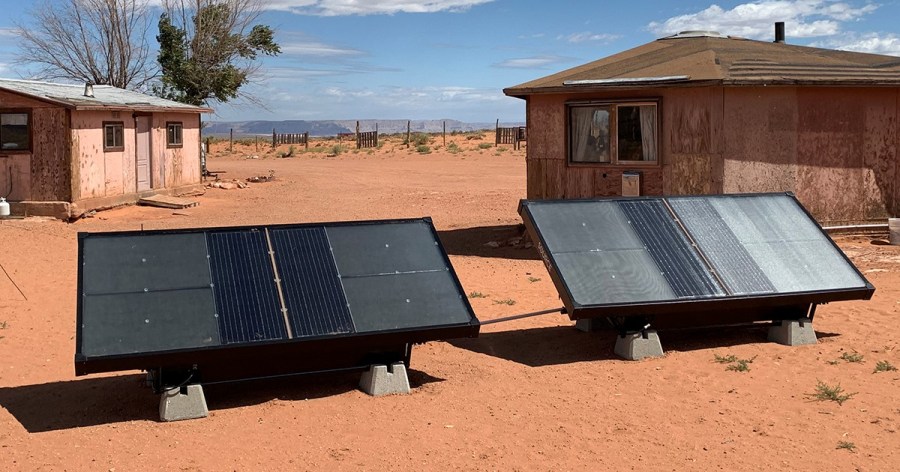Creating water out of thin air in the Navajo Nation

The West is in a drought that’s only getting worse, and drought is an even bigger problem in places that have uneven access to water to start with. In the Navajo Nation, in the southwestern U.S., many homes have no running water at all. The tribe is working with the startup Source, which makes Hydropanels — solar-powered panels that pull water vapor from the air and condense it into clean drinking water.
I spoke with Milton Tso, president of the Cameron chapter in the Navajo Nation, where one family got Source panels this summer. He described the water they make. The following is an edited transcript of our conversation.

Milton Tso: When I was a child, when we went out hunting for small game, my grandfather, when the storm went through, you would have craters in the sandstone that held water. We used to bend over and drink the water out of these craters, and it was pure rainwater. When I first tasted [Hydropanel] water, I just flashed back to that part of my memory. So that’s what the water tastes like. It’s just really clean and pure water. Like it came from the rain.
Molly Wood: And is it the one family in Cameron that has them right now?
Tso: Right now, yeah. People that don’t have running water, some of them have to drive an hour and a half one way to town to get drinking water. People say, “Well, water is not expensive.” Sure, if you have access to the store, it’s around the corner, yes. But for us, the reality is that just going to the town of Flagstaff [in Arizona], you’re spending maybe $50 on gas and other things, when you go buy water in town. A case of bottled water [is] actually costing you around $60, $80.
Wood: How often do people have to go? Can you estimate how much a month that might cost, and how much somebody is, maybe this one household, is saving with the Hydropanels?
Tso: I would think they would go probably three days out of the week to get water. But we also have folks that still rely on their livestock — sheep, cattle, horses — so they’re running almost daily to haul water.
Wood: More broadly, when you look at bringing infrastructure to Cameron and the Navajo Nation — Hydropanels but also renewable energy, new electric grids — do you feel hopeful that the reservation has a chance to maybe create a new vision of energy and water that isn’t so destructive?
Tso: One of the things about climate change, also, is that we get more sunlight now. And I think the tribe itself has a lot of interest in renewable energy. And this energy developed in our community in Cameron could be sold to California and surrounding states. At the same time, we also would like [a] smaller scale of solar energy to homes that are off the grid. That way, we don’t have to run more wires on our land, which is such an eyesore to me. There’s a price you pay, and that price is not only going to be coming out of your pocket, but are you willing to sacrifice the beauty of the land to get power?
Wood: I mean, do you think that can become a model for the rest of the country and other parts of the world?
Tso: I always tell people that are interested in trying something new in Cameron: “We’re willing to try it here. Be the first. If it works here, it’ll work anywhere.”

Related links: More insight from Molly Wood
First, a little more information about these panels and the Navajo Nation. They’re not cheap. A two-panel system costs about $6,000 to install. Grants helped the tribe install panels on 17 homes across the entire Navajo Nation. But Source said it’s working with the tribe to install panels on 500 more homes. The installations are part of the tribe’s COVID-19 response because the pandemic has made the water scarcity problem even worse because people need so much more water for hand-washing and sanitation.
For more on the tech behind these panels, I interviewed Source CEO Cody Friesen last year, back when the company was called Zero Mass Water. In September, the company changed its name, obviously, but also re-incorporated as a public benefit corporation. It’s still a for-profit company, but with a public good at its source. Last June, the company raised an additional $50 million in venture funding from, among others, Bill Gates’ Breakthrough Energy Ventures.
The future of this podcast starts with you.
Every day, the “Marketplace Tech” team demystifies the digital economy with stories that explore more than just Big Tech. We’re committed to covering topics that matter to you and the world around us, diving deep into how technology intersects with climate change, inequity, and disinformation.
As part of a nonprofit newsroom, we’re counting on listeners like you to keep this public service paywall-free and available to all.
Support “Marketplace Tech” in any amount today and become a partner in our mission.


















